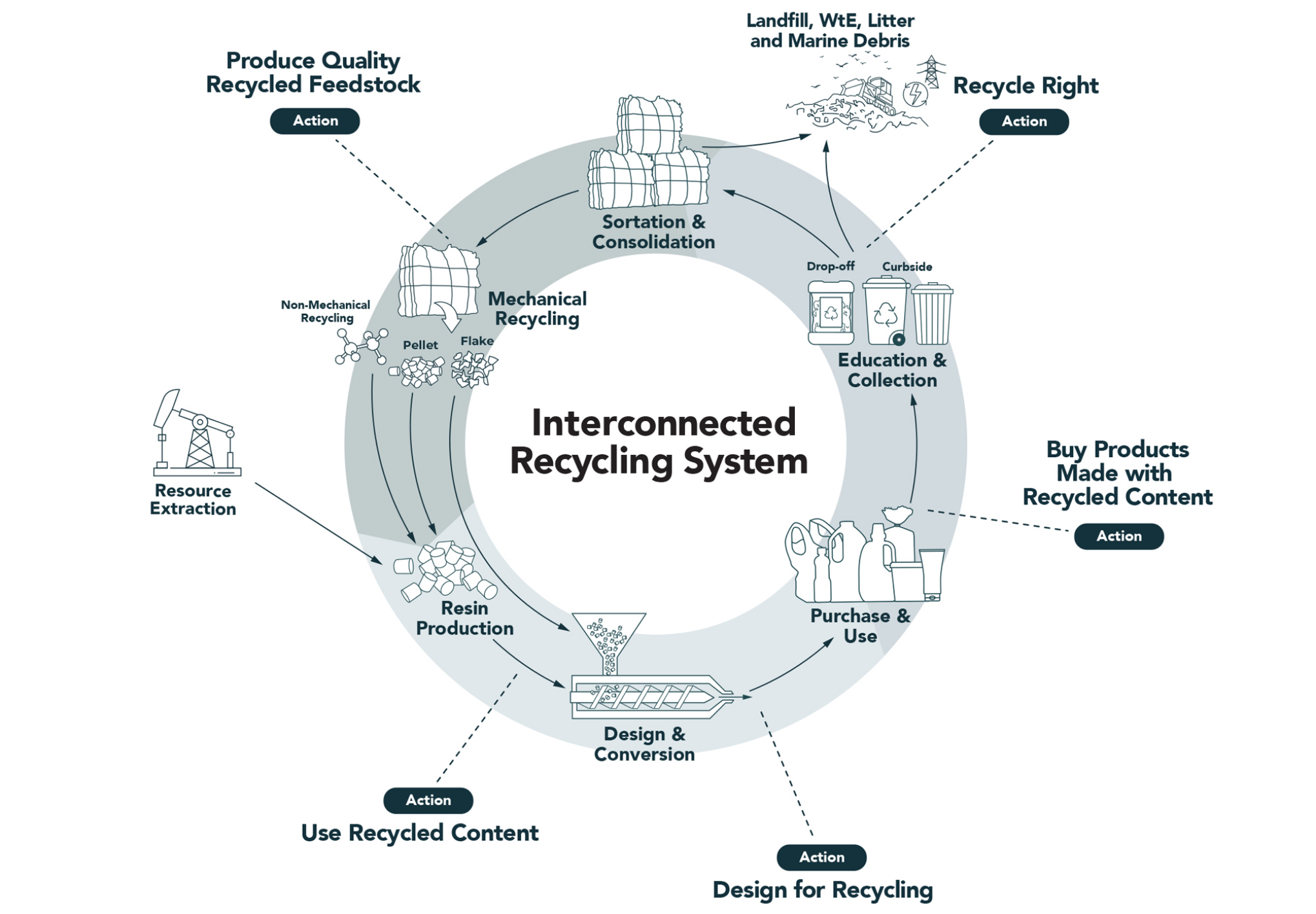Home
Actions for Circularity
U.S. Recycling and Composting
Tools for the Value Chain
Blog
Plastic Tools
Fiber Tools
Metal Tools
Glass Tools
All Tools
Engage with Us


Moving Beyond Morton's Fork
This past December during the holiday spending frenzy, my husband, Matt, and I took off for a music-filled weekend getaway in Hampton, Virginia. They say Virginia is for lovers, but instead of feeling warm fuzzies, I found myself distracted by miles and miles of clear-cut forests and
According to Dogwood Alliance in my home state, "The forest products industry logs 200,000 acres of forests in North Carolina each year (Davis, 2021)." Dogwood Alliance has shed light on the immense impact the highly subsidized wood pellet industry has had while clearing more than 168 acres a day in NC until recently.
According to Dogwood Alliance in my home state, "The forest products industry logs 200,000 acres of forests in North Carolina each year (Davis, 2021)." Dogwood Alliance has shed light on the immense impact the highly subsidized wood pellet industry has had while clearing more than 168 acres a day in NC until recently.
During this time when consumer purchasing peaks towards helping companies get out of the red and into the black, I find myself fixated on the resources those purchases and their packaging use. Recently we've seen more and more companies make a shift to paper and cardboard packaging because of the pushback on single-use plastic packages. As the debate between paper versus plastic continues, it has me pondering the meaning of a Morton's Fork, a dilemma where two choices lead to the same undesirable conclusion. An article in Science Advances last year showed how our way of life is already

The 2023 update to the Planetary boundaries. Download the illustration here.
I can't help but worry that a shift to even more paper or cardboard packaging ultimately will lead to different but equally problematic outcomes as our reliance on plastics has. Concerns around the myriad of risks from plastic are finally front and center in the news, but most of us are less familiar with the impacts from the pulp and paper industry. Most know that paper is relatively recyclable and can be a renewable resource. It's when paper is pushed to function like plastic - e.g., contain liquid - that recyclability issues arise. According to The World Count, paper is quite recyclable, but more than half of the global paper supply comes from newly cut trees, and if everyone consumed paper at the rate of the U.S., Japan and Europe, there would be no trees, much less forests, left. Recycling paper reduces some impacts, such as saving 4,000 kilowatts of energy for every ton recycled. Unfortunately,
Stina Inc.'s Guide to the North Star I'm a fan of visionaries like the late Kim Stanley Robinson who inspire us to think differently and move beyond Morton's Forks. Their creations spark hope for a world in which we learn to invest in what helps us truly thrive on Earth. Can we resolve this old paper-versus-plastic debate? Maybe not, but I think it's more imperative to elevate the discussion to the exploration of a new economic paradigm. One that's regenerative rather than extractive. One that offers the opportunity to sustain life on Earth. This is humanity's collective North Star. Below is a high-level view of Stina Inc.'s guide to reaching this North Star.

Why are "virgin" materials that must be mined, cut or extracted from the Earth, in greater demand than recovered materials? The plastic waste issue is a function of the supply of oil and gas. We have a ridiculous amount of plastic because we are extracting a ridiculous amount of fossil fuels. There is one big inconvenient reality that seems nearly impossible to change: We have a consumption-based economy that depends on continuous growth, but we live on a finite planet. Leaders do not stay in office if they slow the economy, so we have landfill costs that do not include the full cost of waste on human health and the environment, subsidized fossil fuel extraction and even military conflict to help maintain a monetary system that requires constant growth. Until the value of nature and humanity are part of the economic model as articulated in Kim Stanley Robinson's book "Ministry for the Future," we are just following the four horsemen over the cliff. "A new type of thinking is essential if mankind is to survive and move toward higher levels." -Albert Einstein
Why are "virgin" materials that must be mined, cut or extracted from the Earth, in greater demand than recovered materials? The plastic waste issue is a function of the supply of oil and gas. We have a ridiculous amount of plastic because we are extracting a ridiculous amount of fossil fuels. There is one big inconvenient reality that seems nearly impossible to change: We have a consumption-based economy that depends on continuous growth, but we live on a finite planet. Leaders do not stay in office if they slow the economy, so we have landfill costs that do not include the full cost of waste on human health and the environment, subsidized fossil fuel extraction and even military conflict to help maintain a monetary system that requires constant growth. Until the value of nature and humanity are part of the economic model as articulated in Kim Stanley Robinson's book "Ministry for the Future," we are just following the four horsemen over the cliff. "A new type of thinking is essential if mankind is to survive and move toward higher levels." -Albert Einstein
Transparency and accountability offer the catalysts needed to pull us out of the linear model of take-make-waste and into a circular, nature-based economy that allows life to thrive on our planet. Towards that end, we created the CircularityInAction.com platform to feature inspiration from a growing network of people working to preserve resources, recover resources and drive full cost accounting for appropriate offsets (or
A Roadmap Needed - Plastic Film Calls the Question Plastic film, in particular, exposes the need for a shared roadmap on how to manage resources sustainably - one that helps us all navigate the decision of what material to use for a given purpose to achieve the least environmental impact, ideally aid in the regeneration of nature, and then best recover such materials after use. Companies know the advantages of film packaging. Without clear and impactful sustainability goals and metrics - that North Star - guiding decisions, the short-term economic goals and metrics will continue to run the show. It poses significant risk to people, planet and companies as well, which are increasingly called out by watchdog groups and shareholders for "greencrowding", or joining a coalition or adopting a group initiative and then moving at the pace of the slowest participant rather than putting the efforts and resources towards needed initiatives. While plastic film is a highly efficient package, it is one of the largest portions of the plastic waste stream and doesn't have a large-scale, viable recycling option.
Plastic Film Has
Film recycling has seen some years of growth, first due to domestic recyclers with initial seed money from petrochemical companies, and then due to demand from export markets. In more recent years, domestic film collection has continued largely as a function of demand for composite decking. Companies with vertical integration of recycling and manufacturing, such as Trex Company, manufacturer of composite decking, tend to weather headwinds better than the companies that buy baled scrap plastic to produce post-consumer resin. But in an economic system which saw
Searching for Economic Instruments for Recycling Instead of Unicorns
Examples of economic instruments are Bottle Bills, which have been unequivocally effective in increasing bottle and can recovery.
Examples of economic instruments are Bottle Bills, which have been unequivocally effective in increasing bottle and can recovery.
Since plastics are a function of extraction of oil and gas, which benefit from government subsidies, the economics of recycling are stifled. Fiscal commitments to recycling are not attractive because of the economic realities: Disposal costs and new (aka "virgin") plastics are artificially low due to subsidies. Maintaining low disposal costs and cheap fossil fuels, and thus plastics, are essential market conditions for a linear consumer-based economy. In the case of plastic film, millions of Americans still don't know they can recycle their clean, dry plastic film such as bread bags, bathroom tissue overwrap, air pillows and case wrap through store drop-off programs. Millions more likely don't care or just don't have the luxury of worrying about things beyond figuring out how to meet their family's immediate needs. Even if everyone did understand how to recycle right, the reality is our economic system simply does not support the business of recycling. It is a relief that more companies are designing for recyclability, but again our focus can't be siloed - it is an interconnected system. The reclamation capacity is about 5% of the plastic resin production capacity for polyethylene, based on our decades of research and data from Chemical Market Analytics. With nearly
Extended Producer Responsibility (EPR) is a step in the right direction but with fossil fuel subsidies at a record $7 trillion per year driving artificially cheap new plastic pricing it is hard to make the case for recycled goods and recycling.
Extended Producer Responsibility (EPR) is a step in the right direction but with fossil fuel subsidies at a record $7 trillion per year driving artificially cheap new plastic pricing it is hard to make the case for recycled goods and recycling.
Recyclers, which are the engines of the recycling economy, not only face steep economic challenges but are also forced to innovate constantly to adapt to the rapidly changing stream of materials.

We need to see as much investment from companies in using recycled materials in their products and using products with recycled content as there is in achieving recyclability. There is a lot of plastic out in the world but too few channels open to getting the material back into commerce. Due to such little value placed on recovered goods or recycled content, there is little return on investment for large-scale infrastructure to collect, sort and reprocess plastic. Given we can order things for delivery overnight, the logistics exist to build a network of recovery, just not the economic drivers.

Close of a Chapter That Taught Us a Lot - Shutting Down a 20-Year-Old Directory As CEO of Stina Inc., a mission-based environmental research and technology company, it's my job to examine the impact of our company's work. This year, I am contemplating what impact our decision to deactivate the plastic
Late in 2022 we lost industry sponsorship for the directory. Contrary to consumer perception, the directory was not supported through labeling programs or brand companies that used the labels. For nearly a year, Stina Inc. self-funded the resource to help people recycle household plastic film while asking for support from the film value chain. More than six film recyclers joined the film recycling steering committee to direct the content of BagandFilmRecycling.org. Late in 2023, three brand companies stepped up to keep the directory active. However, it was not enough for our team to continue to vet and verify information for the site or provide the support needed to develop a healthy recovery ecosystem for film. Maintaining a resource without industry engagement is an exercise in futility. The final factors in our decision to shut down the directory were the announcements by other organizations of the desire to duplicate it. It's not easy to build a good film drop-off directory, but it doesn't take rocket science, either. You need to know the recyclers so you can triangulate information, like where the material is ending up, but I think it was the nuances in information about the plastic film recycling landscape that made Stina Inc. well suited to support this type of resource and the recyclers still swimming against the tide. We remain fully committed to collaboration and engaging with players in the value chain to support recycling. Accurate information is important to us. The most credible alternative to the directory that we can offer is the
Evolving Beyond Business as Usual For the last six years our company has been shifting, learning and gathering information. We evolved out of Moore Recycling Associates, a consulting and management company, and have restructured as a research and technology company. We have forged new partnerships that demonstrate that collaboration is better than competition for us in fulfilling our mission and vision, a shift we believe is essential in the transition from a linear economy to a circular one. We are focused on the collective North Star and excited to partner with others to illuminate the guide to sustainable use of resources to sustain life on Earth. As a quote attributed to Buckminster Fuller says, "You never change things by fighting the existing reality. To change something, build a new model that makes the existing model obsolete."
"In 2019, the latest year of data at the time of writing, we mined, dug, and blasted more materials from the earth's surface than the sum total of everything we extracted from the dawn of humanity all the way through 1950," wrote Ed Conway in his recent book,
"In 2019, the latest year of data at the time of writing, we mined, dug, and blasted more materials from the earth's surface than the sum total of everything we extracted from the dawn of humanity all the way through 1950," wrote Ed Conway in his recent book,
As shown in our Sustaining Life on Earth diagram, we believe that full cost accounting is needed to truly unlock the innovation needed to move beyond Morton's Fork and the options that fail to sustain life on Earth. Documenting the state of how material is collected, recycled and made into new products is needed if the public is to have any faith in recycling. Greater transparency and value for what sustains life is needed to drive the economic instruments that will lead to more sustainable use of resources. Reports and sound bites that state recycling is a sham and discourage people from recycling are a distraction. With better access to data, perhaps in our lifetime, use of "virgin" materials will become passe and recycled materials become the sexier option. We already have Annual Plastic Recycling Study to report on how much film and other plastics are recovered for recycling, with efforts to document more in the plastic recycling landscape. We will continue to provide tools such as a recycled products directory to connect people to products that facilitate recycling beyond collection. Please also explore
What We All Can Do While systemic change is needed, we can also make differences as ordinary individuals. Some ideas for how to catalyze the shift to circularity: Stop, think and avoid unnecessary and/or toxic stuff. Below are some apps that provide insights about potentially toxic ingredients. - yuka.io/en Buy local. Re-embrace reuse. Find a favorite reusable mug, bag, cutlery, water bottle and storage container. I keep them in my backpack or stash in the car. Check out Refillery Collective for lists of refill and zero-waste stores near you. Recycle items your community recycling program accepts. Continue taking bag and film items such as clean, dry bread bags and bathroom tissue overwrap to participating retailers. Plastic Ocean Project. Send your feedback to companies and policy makers. Get outside for a walk or other activity to enjoy the outdoors every day. Grow something: food, native plants, trees, etc. Thank you for reading and let me know at

Nina Bellucci Butler is the CEO of Stina Inc., which is a mission-based research and technology company providing unbiased guidance to governments, industry, and NGOs in the movement toward circularity, navigating choices to preserve and recover the resources we use. The reality of plastics and plastic recycling has been a key focus of Stina Inc.'s work.

Nina Bellucci Butler is the CEO of Stina Inc., which is a mission-based research and technology company providing unbiased guidance to governments, industry, and NGOs in the movement toward circularity, navigating choices to preserve and recover the resources we use. The reality of plastics and plastic recycling has been a key focus of Stina Inc.'s work.
Resources Black, S., Parry, I. & Vernon, N. (2023, August 24). Fossil fuel subsidies surged to record $7 trillion: Scaling back subsidies would reduce air pollution, generate revenue, and make a major contribution to slowing climate change. IMF Blog. https://www.bfi.org/ Catlin, J. R. & Wang, Y. (2012, May 10). Recycling Gone Bad: When the Option to Recycle Increases Resource Consumption. Journal of Consumer Psychology. doi:10.1016/j.jcps.2012.04.001, Retrieved at SSRN: https://www.ted.com/speakers/ralph_chami Conway, E. (2023). Material world: The six raw materials that shape modern civilization. Alfred A. Knopf. Davis, S. (2021, March 8). All about forest carbon in North Carolina. Dogwood Alliance. https://www.npr.org/2023/01/31/1152776315/exxon-mobil-earnings-chevron-big-oil-biden-windfall-tax#:~:text=28%2C%202022.-,ExxonMobil%20posted%20record%20earnings%20in%202022%2C%20benefitting,a%20surge%20in%20oil%20prices.&text=ExxonMobil%20earned%20nearly%20%2456%20billion,U.S.%20or%20European%20oil%20giant. Elhachem, E., Ben-Uri, L., Grozovski, J., Bar-On, Y.M., & Milo, R. Global human-made mass exceeds all living biomass. Nature, Vol 288. 442-444. https://www.imf.org/en/Topics/climate-change/energy-subsidies Kenton, W. (2024, January 24). Externality: What it means in economics, with positive and negative examples. Investopedia. https://www.kimstanleyrobinson.info/content/ministry-future-upon-us Richardson, K., Steffen, W., Lucht, W., Cornell, S., Donges, J.F., Drke, M., Fetzer, I., Bala, G., Von Bloh, W., Feulner, G., Fiedler, S., Gerten, D., Gleeson, T., Hofmann, M., Huiskamp, W., Kummu, M., Mohan, C., Nogus-Bravo, D., Petri, S., Porkka, M., . . . Rockstrm, J. (2023, September 23). Earth beyond six of nine planetary boundaries. Science Advances, Vol 9.(37) https://www.theworldcounts.com/challenges/state-of-the-planet/when-will-the-world-run-out-of-water Stina Inc. (2023, June). Summary report: Documenting the stakeholder process and key elements for the availability of film drop-off recycling study methodology. https://www.theworldcounts.com/challenges/consumption/other-products/environmental-impact-of-paper Tsiamis, D.A., Torres, M., & Castaldi, M.J. (2018). Role of plastics in decoupling municipal solid waste and economic growth in the U.S. Waste Management. Vol(77). 147-155. https://www.un.org/en/climatechange/science/climate-issues/greenwashing
